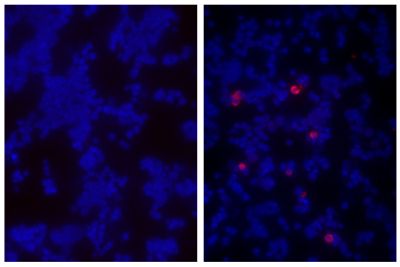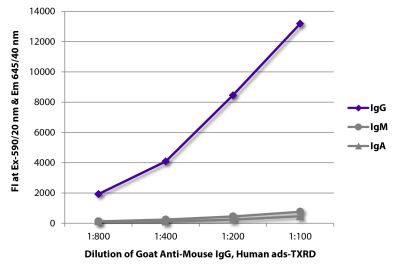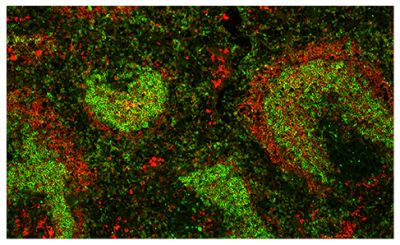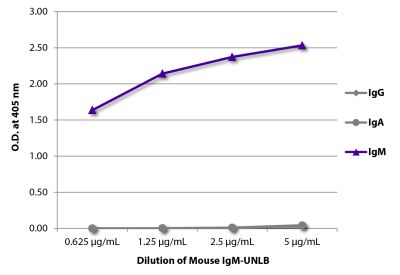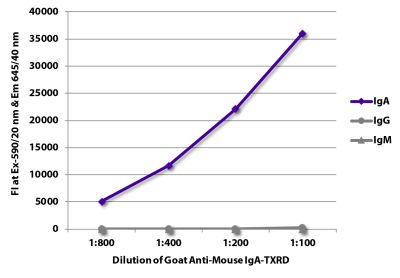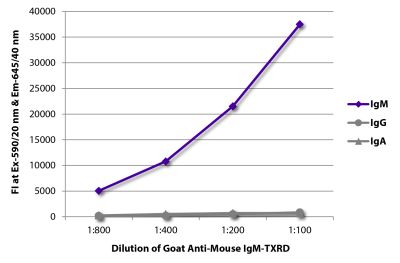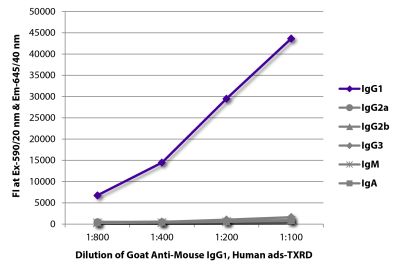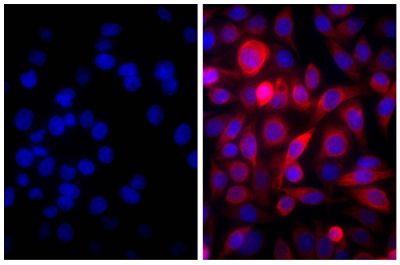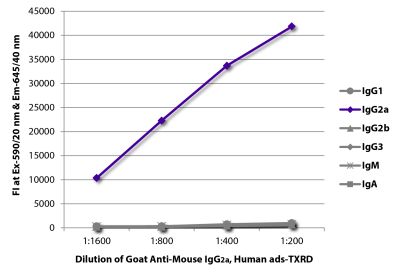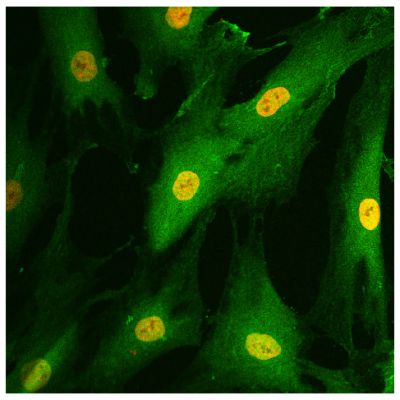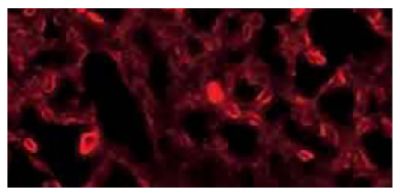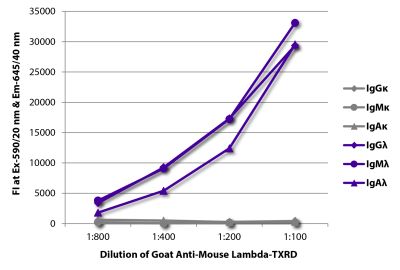Goat Anti-Mouse IgM, Human ads-TXRD
Cat. No.:
1020-07
Goat Anti-Mouse IgM-Texas Red antibody with minimal reactivity to human proteins for use in flow cytometry and immunohistochemistry / immunocytochemistry assays.
$168.00
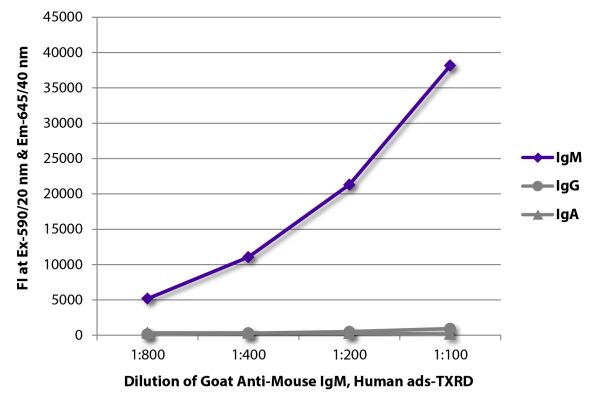




| Isotype | Goat IgG |
|---|---|
| Isotype Control | Goat IgG-TXRD |
| Specificity | Reacts with the heavy chain of mouse IgM |
| Source | Pooled antisera from goats hyperimmunized with mouse IgM |
| Cross Adsorption | Mouse IgG and IgA; human immunoglobulins and pooled sera; may react with immunoglobulins from other species |
| Purification Method | Affinity chromatography on mouse IgM covalently linked to agarose |
| Conjugate | TXRD (Texas Red®) |
| Buffer Formulation | Phosphate buffered saline containing < 0.1% sodium azide |
| Clonality | Polyclonal |
| Concentration | 1.0 mg/mL |
| Volume | 1.0 mL |
| Recommended Storage | 2-8°C; Avoid exposure to light |
| Trademark Information | Texas Red® is a registered trademark of Thermo Fisher Scientific, Inc. or its subsidiaries |
| Applications |
Quality tested applications for relevant formats include - ELISA 1-11 FLISA Flow Cytometry 4,7,10,13-17 Other referenced applications for relevant formats include - ELISpot 2,3,5,6,8-10,12 Immunohistochemistry-Frozen Sections 1,7,18-22 Immunohistochemistry-Paraffin Sections 28 Immunocytochemistry 1,13,23 Electron Microscopy 19 Western Blot 14,16,24 Immunoprecipitation 24,29,30 Purification 26 Stimulation 14,25-27 |
| RRID Number | AB_2794203 |
| Gene ID |
16019 (Mouse) |
| Gene ID Symbol |
Ighm (Mouse) |
| Gene ID Aliases | AI326478; Igh-6; Igh-M; Igh6; Igm; muH |
| UniProt ID |
P01872 (Mouse |
| UniProt Name |
IGHM_MOUSE (Mouse) |
Documentation
Certificate of Analysis Lookup
Enter the Catalog Number and Lot Number for the Certificate of Analysis you wish to view
- 1. Oliver AM, Martin F, Kearney JF. IgMhighCD21high lymphocytes enriched in the splenic marginal zone generate effector cells more rapidly than the bulk of follicular B cells. J Immunol. 1999;162:7198-207. (ELISA, IHC-FS, ICC)
- 2. Lagrota-Candido J, Vasconcellos R, Cavalcanti M, Bozza M, Savino W, Quirico-Santos T. Resolution of skeletal muscle inflammation in mdx dystrophic mouse is accompanied by increased immunoglobulin and interferon-γ production. Int J Exp Path. 2002;83:121-32. (ELISA, ELISPOT)
- 3. Hovden A, Cox RJ, Haaheim LR. Whole influenza virus vaccine is more immunogenic than split influenza virus vaccine and induces primarily an IgG2a response in BALB/c mice. Scand J Immunol. 2005;62:36-44. (ELISA, ELISPOT)
- 4. Ippolito GC, Schelonka RL, Zemlin M, Ivanov II, Kobayashi R, Zemlin C, et al. Forced usage of positively charged amino acids in immunoglobulin CDR-H3 impairs B cell development and antibody production. J Exp Med. 2006;203:1567-78. (ELISA, FC)
- 5. Huang L, Adachi T, Shimizu Y, Goto Y, Toyama J, Tanaka H, et al. Characterization of lectin isolated from Momordica charantia seed as a B cell activator. Immunol Lett. 2008;121:148-56. (ELISA, ELISPOT)
- 6. Patterson HC, Kraus M, Wang D, Shahsafaei A, Henderson JM, Seagal J, et al. Cytoplasmic Igα serine/threonines fine-tune Ig α tyrosine phosphorylation and limit bone marrow plasma cell formation. J Immunol. 2011;187:2853-8. (ELISA, ELISPOT)
- 7. Wang JH, Wu Q, Yang P, Li H, Li J, Mountz JD, et al. Type I IFN-dependent CD86high marginal zone precursor B cells are potent T cell costimulators. Arthritis Rheum. 2011;63:1054-64. (ELISA, FC, IHC-FS)
- 8. Conway KL, Kuballa P, Khor B, Zhang M, Shi HN, Virgin HW, et al. ATG5 regulates plasma cell differentiation. Autophagy. 2013;9:528-37. (ELISA, ELISPOT)
- 9. Goenka R, Matthews AH, Zhang B, O'Neill PJ, Scholz JL, Migone T, et al. Local BLyS production by T follicular cells mediates retention of high affinity B cells during affinity maturation. J Exp Med. 2014;211:45-56. (ELISA, ELISPOT)
- 10. Shen P, Roch T, Lampropoulou V, O'Connor RA, Stervbo U, Hilgenberg E, et al. IL-35-producing B cells are critical regulators of immunity during autoimmune and infectious diseases. Nature. 2014;507:366-70. (ELISA, ELISPOT, FC)
- 11. Pucella JN, Yen W, Kim MV, van der Veeken J, Socci ND, Naito Y, et al. miR-182 is largely dispensable for adaptive immunity: lack of correlation between expression and function. J Immunol. 2015;194:2635-42. (ELISA)
- 12. Shin C, Han J, Koh H, Choi B, Cho Y, Jeong H, et al. CD8α- dendritic cells induce antigen-specific T follicular helper cells generating efficient humoral immune responses. Cell Rep. 2015;11:1929-40. (ELISPOT)
- 13. Eaton-Bassiri AS, Mandik-Nayak L, Seo S, Madaio MP, Cancro MP, Erikson J. Alterations in splenic architecture and the localization of anti-double-stranded DNA B cells in aged mice. Int Immunol. 2000;12:915-26. (FC, ICC)
- 14. Geraldes P, Rebrovich M, Herrmann K, Wong J, Jäck H, Wabl M, et al. Ig heavy chain promotes mature B cell survival in the absence of light chain. J Immunol. 2007;179:1659-68. (FC, WB, Stim)
- 15. Zhou X, Xiang Y, Ding X, Garrard WT. A new hypersensitive site, HS10, and the enhancers, E3' and Ed, differentially regulate Igκ gene expression. J Immunol. 2012;188:2722-32. (FC)
- 16. Alkhatib A, Werner M, Hug E, Herzog S, Eschbach C, Faraidun H, et al. FoxO1 induces Ikaros splicing to promote immunoglobulin gene recombination. J Exp Med. 2012;209:395-406. (FC, WB)
- 17. Bai L, Deng S, Reboulet R, Mathew R, Teyton L, Savage PB, et al. Natural killer T (NKT)-B-cell interactions promote prolonged antibody responses and long-term memory to pneumococcal capsular polysaccharides. Proc Natl Acad Sci USA. 2013;110:16097-102. (FC)
- 18. Raats CJ, van den Born J, Bakker MA, Oppers-Walgreen B, Pisa BJ, Dijkman HB, et al. Expression of agrin, dystroglycan, and utrophin in normal renal tissue and in experimental glomerulopathies. Am J Pathol. 2000;156:1749-65. (IHC-FS, EM)
- 19. Mattsson N, Duzevik EG, Pelsue SC. Expansion of CD22lo B cells in the spleen of autoimmune-prone flaky skin mice. Cell Immunol. 2005;234:124-32. (IHC-FS)
- 20. Neese W, Westra J, van der Wal JE, Abbas F, Nicholas AP, Vissink A, et al. The periodontium of periodontitis patients contains citrullinated proteins which may play a role in ACPA (anti-citrullinated protein antibody) formation. J Clin Periodontol. 2012;39:599-607. (IHC-FS)
- 21. Simonetti G, Carette A, Silva K, Wang H, De Silva NS, Heise N, et al. IRF4 controls the positioning of mature B cells in the lymphoid microenvironments by regulating NOTCH2 expression and activity. J Exp Med. 2013;210:2887-902. (IHC-FS)
- 22. Ren W, Lagerstedt K, Grimsholm O, Stern A, Sun J, Fang Y, et al. Uncoupling of natural IgE production and CD23 surface expression levels. PLoS One. 2013;8(4):e62851. (IHC-FS)
- 23. Häggqvist B, Hultman P. Effects of deviating the Th2-response in murine mercury-induced autoimmunity towards a Th1-response. Clin Exp Immunol. 2003;134:202-9. (ICC)
- 24. Elkabetz Y, Shapira I, Rabinovich E, Bar-Nun S. Distinct steps in dislocation of luminal endoplasmic reticulum-associated degradation substrates: roles of endoplamic reticulum-bound p97/Cdc48p and proteasome. J Biol Chem. 2004;279:3980-89. (WB, IP)
- 25. Kato I, Takai T, Kudo A. The pre-B cell receptor signaling for apoptosis is negatively regulated by FcγRIIB. J Immunol. 2002;168:629-34. (Stim)
- 26. Su Y, Flemming A, Wossning T, Hobeika E, Reth M, Jumaa H. Identification of a pre-BCR lacking surrogate light chain. J Exp Med. 2003;198:1699-706. (Purification, Stim)
- 27. Wolkerstorfer S, Schwaiger E, Rinnerthaler M, Gratz IK, Zoegg T, Brandstetter H, et al. HAX1 deletion impairs BCR internalization and leads to delayed BCR-mediated apoptosis. Cell Mol Immunol. 2015;Apr 13:doi: 10.1038/cmi.2015.018. [Epub ahead of print]. (Stim)
- 28. SouthernBiotech published data (IHC-PS)
- 29. Koenig P, Nicholls PK, Schmidt FI, Hagiwara M, Maruyama T, Frydman GH, et al. The E2 ubiquitin-conjugating enzyme UBE2J1 is required for spermiogenesis in mice. J BIol Chem. 2014;289:34490-502. (IP)
- 30. Ouchida R, Lu Q, Liu J, Li Y, Chu Y, Tsubata T, et al. FcμR interacts and cooperates with the B cell receptor to promote B cell survival. J Immunol. 2015;194:3096-101. (IP)
See All References


